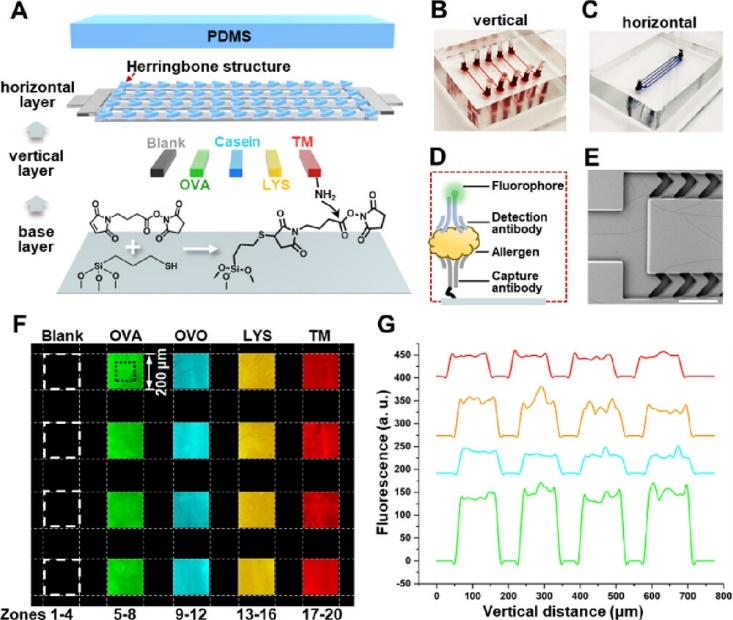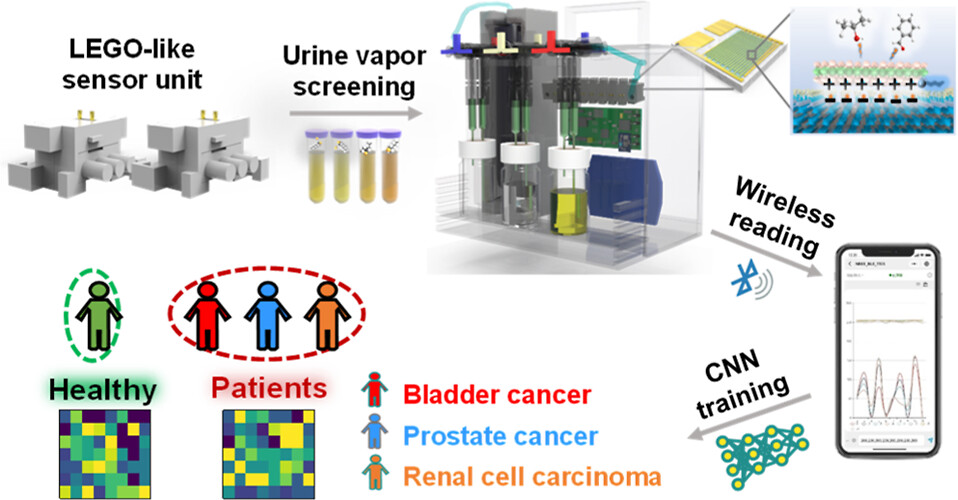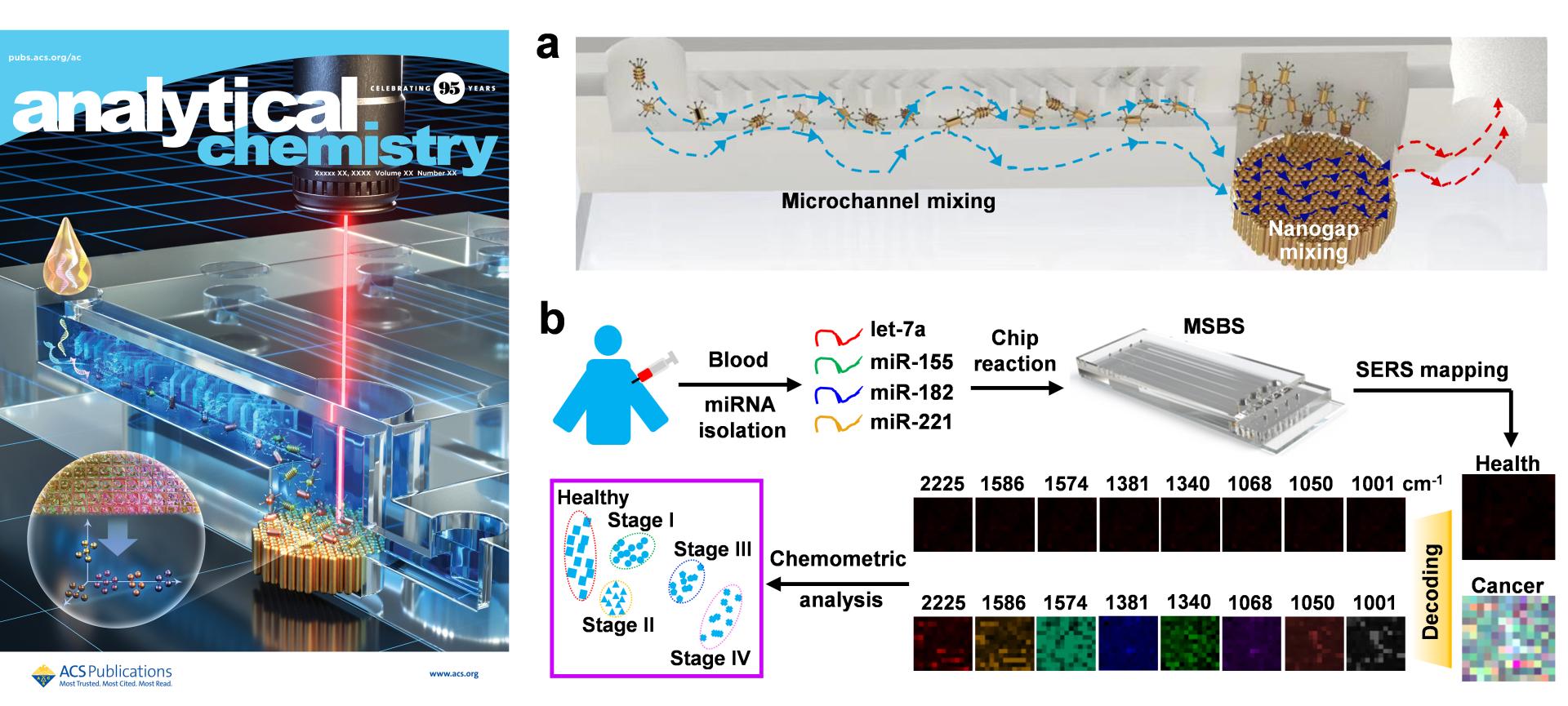Dr. Zheng Li and coworkers from IAS, Shenzhen University have recently published several research work related to biomedical diagnosis and public health monitoring in Analytical Chemistry (CAS Class I, Nature Index Journal).
On Apr. 25, we reported an ELISA-based herringbone microfluidic chip (ELISA-HB-Chip) for rapid and ultrasensitive detection of foodborne allergens in bioaerosols. Food allergy has posed a great threat to human beings that may cause a series of respiratory, skin, or gastrointestinal diseases, or even cause people to death. Exposures to food allergens in particular scenarios such as environmental aerosols are unconscious and unavoidable, which may cause greater damages to humans than regular food intake. Conventional detection methods for food allergens rely on bulk instrumentation and highly trained personnel, which limits their field uses. The in-situ detection for food allergens in aerosols therefore becomes urgent.
This work innovatively developed an ELISA method on a microfluidic platform to study multiplexed detection of key food allergens. This microdetector is of tiny size and equipped with dual functions of fluorescent microscopic imaging and bioaerosol sampling, which is versatile, portable, and easy to use in the field. Therefore, it is able to provide allergic patients with timely and accurate suggestions on effective avoidance of foodborne antigens. This work titled “Enzyme-Linked Immunosorbent Assay-Based Microarray on a Chip for Bioaerosol Sensing: Toward Sensitive and Multiplexed Profiling of Foodborne Allergens” is published inAnalytical Chemistry; Dr. Xiaofeng Chen, a postdoctoral fellow from IAS is the first author.
Paper link:https://pubs.acs.org/doi/full/10.1021/acs.analchem.3c00591

Figure 1.Schematic of the ELISA-HB-chip. (A) Structure of the ELISA-HB-chip, which consists of base, vertical, and horizontal layers. Photograph of the B) vertical and (C) horizontal chip made of PDMS. (D) Chemical principle of the ELISA-HB-chip based on the classic double-antibody sandwich reaction. (E) SEM micrograph of the hannels in the horizontal chip with the herringbone microstructure. The scale bar is 300 μm. (F) Fluorescence imaging result showing the 4 × 5 array of 16 detection zones targeting the four foodborne allergens and four blank regions for background correction. (G) Distribution of the absolute fluorescence intensity in response to the above four allergens at designated concentrations cross the center of each detection zone.
On Sep. 22, we reported an innovative research achievement that successfully combines the array of conductive gas sensor system, chemiresistive volatile profiling system (CVPS), with a chaotic microfluidic technology for real-time monitoring of volatile from urine and for accurate diagnosis and classification of urinary tract cancers. Urinary tract cancers, including bladder cancer, prostate cancer, and renal cell carcinoma, are among the most malignant tumors with high incidence and mortality rates. Currently, the detection and monitoring of urinary tract cancers often rely on invasive methods such as tumor tissue pathological examination and imaging features. Volatile metabolites can reflect the physiological and pathological conditions of individuals and have become ideal biomarkers for noninvasive cancer detection. However, a portable and real-time detection method is still missing that can interpret complex electrochemical signals and comprehensively differentiate similar phenotypes of urinary tract cancers.
The research innovatively reported a LEGO-inspired CVPS, which can real-time and multiplex monitoring of volatile organic compounds in urine and early detection and classification of urinary tract cancers at different stages or metastatic states on a smartphone. The core part of CVPS is an eight-channel gas sensor array composed of positively charged MXene materials and eight negatively charged TMDC materials. These sensor chips are embedded into LEGO-like units, and when in contact with volatile organic compounds, the electrical signals of individual chips are wirelessly transmitted to mobile devices in real-time via wireless monitoring. With the integration of a point-of-care testing platform and efficient machine learning algorithms, this technology can reliably identify and classify healthy or diseased samples of urinary tract cancer subgroups (i.e., tumor subtypes, staging, lymph node metastasis, and distant metastasis) within minutes, with high sensitivity and specificity. This research achievement was published under the title “Rapid Diagnosis of Urinary Tract Cancers on a LEGO-Inspired Detection Platform via Chemiresistive Profiling of Volatile Metabolites” inAnalytical Chemistry. The first author of the paper is Linlin Sun, a graduate student from IAS.
Paper link:https://pubs.acs.org/doi/10.1021/acs.analchem.3c03252.

Figure 2.A schematic diagram of the chemiresistive volatile profiling system (CVPS) used for urine volatile detection. Firstly, a LEGO-inspired gas sensing element based on two-dimensional material composites is constructed. Then, it is assembled on a portable integrated sensing platform for sensing detection of volatile gases generated by bubbling urine samples. The electrochemical impedance signals are transmitted to a mobile phone via Bluetooth and the data is trained and learned using a convolutional neural network algorithm. Finally, the health or disease category to which the sample belongs is predicted and classified.
On Oct. 2, we reporteda versatile microfluidic-SERS barcoding system (MSBS) for multiplexed determination of four key miRNAs and further to discriminate cancer from healthy cohorts, to classify different stages and subtypes of cancers, and to predict the occurrence of distant metastasis for early cancer diagnosis
MicroRNAs (miRNAs) represent a class of evolutionarily conserved, endogenous, noncoding, and circulated small RNAs. The dysregulated expression of miRNAs is closely associated with the onset of a myriad of diseases, including cancers and cardiovascular diseases. Studies have revealed that the emergence of a specific tumor may be associated with the abnormal expression of multiple miRNAs. An effective profiling methodology for miRNAs and the relevant cancer diseases is therefore imperative for timely and precise clinical diagnosis in liquid biopsy.
A versatile microfluidic-SERS barcoding system is developed for sensitive and multiplexed imaging of circulating microRNAs through interfacial probing of encoded nanorod aggregates at diverse patterned nanogaps. The use of a single-layer, vertically oriented nanorod array creates a plasmonic coupling-based electromagnetic field with enormously enhanced Raman outputs. The introduction of the herringbone micromixer with circulated microflow sampling accelerates the hybridization and capture of nanorod aggregates on the plasmonic substrate. The method is able to achieve ideal sensitivities at subfemtomolar levels for four miRNAs, with multiplexed assay capability for an integrated liquid biopsy. The on-chip digital profiling of serum miRNAs in mapping and barcoding formats enable both clear discrimination of untreated cancer patients from the healthy cohort and precise classification of tumor stages, metastatic conditions, and subtypes, with an overall accuracy of 94%. The SERS-based microfluidic barcoding system therefore holds great promise in early cancer screening, diagnosis, and prognosis.
The relevant results are entitled "Interfacial Profiling of MicroRNAs at Patterned Nanogaps for an Integrated Microfluidic-SERS Liquid Biopsy" was published and selected as theFront CoverinAnalytical Chemistry. Dr. Xiaohui Lu, a postdoctoral fellow from IAS, is the first author of the paper.
Paper link:https://pubs.acs.org/doi/full/10.1021/acs.analchem.3c02945

Figure 3.Front cover and schematic of the microfluidic-SERS barcoding system (MSBS) for multiplexed detection of miRNAs and early cancer diagnosis. (a) Serum analysis on the chip. The hybridization of nanorods and capture of nanorod aggregates was driven by in-channel micromixing effect and circulated nanomixing force amongst nanorod vertical array. (b) On-chip SERS mapping was performed on serum samples from cancer patients at stages I–IV and healthy participants for their discrimination. SERS mapping images with pseudo colors reflect the expression level of each miRNA biomarker.
Dr. Zheng Li serves as the unique corresponding authors of the above work. The research work is supported by the grants from the National Natural Science Foundation of China, the Natural Science Foundation of Guangdong Province for Distinguished Young Scholars, and Shenzhen University 2035 Program for Excellent Research.


